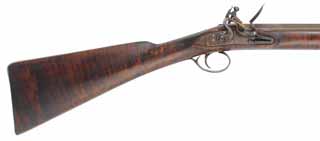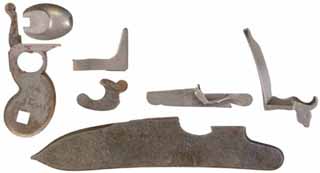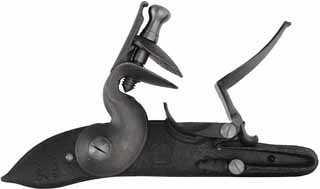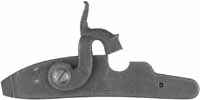Your search for 'flint'
returned
747 results.

|
American Fowling Gun , 20 gauge, 42" octagon-to-round barrel, late Ketland flintlock, maple, patina finished iron, used, by Steve Losey
A very utilitarian fowler with a 20 gauge, 42" octagon-to-round barrel, maple stock, Jim Chambers late Ketland flintlock, and English influenced iron furniture. The breech is signed by contemporary builder Mr. Steve Losey. Weighing in at 6.7 pounds, this fowler has a trigger reach of 13-1/2" making it well suited for today's average size shooter. T
|

|
1763 Charleville & 1795 Springfield lock castings
New wax cast parts, for the experienced lock maker. Not a kit! The armories of France lead the world in advanced military musket design and production, during the 1700 - 1830 period. So many French musket models and variations were made and tested, even advanced collectors find the distinctions confusing. These parts are apparently exact copies f
|

|
Brown Bess 1746 ~ Willits lock kit, fully assembled, tested, with tempered springs and parts, not polished
1746 - Willits, Brown Bess Musket Flint Lock Kit This lock kit is now fully assembled , tested for correct function, not polished. These First Model Brown Bess lock parts are cast directly from an original antique lock, by Willits - 1746. Parts are precision CNC machined, tempered, fitted and assembled. Overal length 6.68" by 1.18" tall. The ma
|

|
Ketland late conversion cap lock, by R. E. Davis
Build an early percussion longrifle, or converted flint Tennessee or late longrifle using our late Ketland cap lock. This “conversion" lock interchanges with our late Ketland flint lock. If you are planning a gun with interchangeable ignition, we recommend fitting the percussion lock first, to insure a good fit of the drum to the lock plate. The pl
|

|
John Bailes - London, right Percussion Conversion Lock, by L&R
John Bailes - London, right Percussion Conversion Lock Fine original flint locks were converted to percussion, during the 1825 to 1880 period. The flash hole was replaced with a powder drum and nipple, which we offer separately. Old time gunsmiths cut away the pan, discarded the frizzen, frizzen spring, and cock. A new hammer was added, and scre
|

|
cock, left, wax cast steel, 1.4" throw, tapped 1/4-28
cock, left, wax cast steel, 1.4" throw, tapped 1/4-28 A fly detent prevents the sear from snagging the half-cock notch when fired. Used with plain or set triggers. Nearly as large as the left Siler lock, it will fit straight or swamped barrels from 3/4" to 1-1/8" octagon at the breech. Notice the "cut away" tumbler and "swing out" link, which great
|

|
frizzen, left, wax cast steel, as cast, temper after fitting
frizzen, left, wax cast steel, as cast, temper after fitting A fly detent prevents the sear from snagging the half-cock notch when fired. Used with plain or set triggers. Nearly as large as the left Siler lock, it will fit straight or swamped barrels from 3/4" to 1-1/8" octagon at the breech. Notice the "cut away" tumbler and "swing out" link, whic
|

|
Mainspring , left, tempered steel, tempered
mainspring, left, tempered steel, tempered A fly detent prevents the sear from snagging the half-cock notch when fired. Used with plain or set triggers. Nearly as large as the left Siler lock, it will fit straight or swamped barrels from 3/4" to 1-1/8" octagon at the breech. Notice the "cut away" tumbler and "swing out" link, which greatly simplify
|

|
plate, left, wax cast steel, .94" x 5.1", tapped 6-40
plate, left, wax cast steel, .94" x 5.1", tapped 6-40 A fly detent prevents the sear from snagging the half-cock notch when fired. Used with plain or set triggers. Nearly as large as the left Siler lock, it will fit straight or swamped barrels from 3/4" to 1-1/8" octagon at the breech. Notice the "cut away" tumbler and "swing out" link, which great
|

|
Siler large left Percussion Conversion Lock, by Jim Chambers
Siler large left Percussion Conversion Lock Ideal for a left hand percussion longrifle, this Germanic style lock has the long pointed tail, raised lock plate with chamfered edges, and filed moulding across the tail, styles used during the 1750 - 1780 flint lock era. Originally designed as a flint lock, many longrifles were converted to percussio
|

|
Siler large right Percussion Conversion Lock, by Jim Chambers
Siler large right Percussion Conversion Lock Ideal for a percussion longrifle, this Germanic style lock has the long pointed tail, raised lock plate with chamfered edges, and filed moulding across the tail, styles used during the 1750 - 1780 flint lock era. Originally designed as a flint lock, many longrifles were converted to percussion during
|

|
Allentown-Bethlehem , pre shaped, pre-inlet stocks, 13/16", & 7/8" octagon 42" barrel, cut for large Siler lock
This gently curved stock is modeled after those made in Allentown-Bethlehem, Pennsylvania. This stock style is also similar to those made by A. Verner, of Buck’s County, Pennsylvania. Our pre-inlet stocks are cut for either a 13/16”, or 7/8" straight octagon 42" barrel, pre-cut for a flared tang breech plug. The 3/8” ramrod hole is drilled full dep
|

|
Bedford County , pre shaped, pre-inlet stocks, 13/16", or 7/8" octagon 42" barrel, L&R Bedford lock
Studying the longrifles of Bedford County, Pennsylvania, might cause you to imagine that time nearly stopped in Bedford County, or that this region was isolated from the world. How can we explain why these men continued to make Bedford County rifles for over 120 years, much later than we might expect? How can we explain these very odd locks, with l
|

|
stock, Bedford County , pre-inlet, 13/16" octagon 42" barrel, L&R Bedford lock, plain maple
Studying the longrifles of Bedford County, Pennsylvania, might cause you to imagine that time nearly stopped in Bedford County, or that this region was isolated from the world. How can we explain why these men continued to make Bedford County rifles for over 120 years, much later than we might expect? How can we explain these very odd locks, with l
|

|
stock, Bedford County , pre-inlet, 13/16" octagon 42" barrel, L&R Bedford lock, fancy maple
Studying the longrifles of Bedford County, Pennsylvania, might cause you to imagine that time nearly stopped in Bedford County, or that this region was isolated from the world. How can we explain why these men continued to make Bedford County rifles for over 120 years, much later than we might expect? How can we explain these very odd locks, with l
|